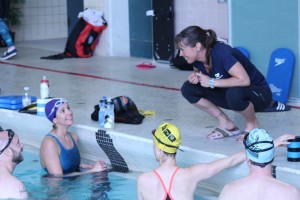Part II – Equipment for Training & Racing
- by Coach Nick
Above and beyond the obvious difference of water between pool swimming and open water swimming, there is also a slight difference in the equipment used in the training sessions. In this article let’s jump into the different types of swim toys used, types of goggles, and the difference between swimsuits & wetsuits.
During a pool swim you have the luxury of being able to keep a flutter board, pull buoy, paddles, and other equipment on deck but in open water you do not have a pool ledge with easy access. When out in open water the main goal for a lot of swimmers is to get familiar with having no line to follow at the bottom of the pool and being able to spot (sight).
Spotting is a technique swimmers use that uses above-water landmarks for guidance. These landmarks can be anything that is large enough and used as a target to swim towards – usually buoys. Having the ability to get in open water and practice spotting can be a huge advantage heading into a race since the swim stroke is slightly adapted to allow for a forward glance in addition to side breathing. During training try to pick small objects to use as spotting targets so during a race it will feel easier to use the big buoys. You can also practice this spotting technique in the pool by placing a water bottle on the pool ledge and practice spotting and breathing like you would in open water.
The above sounds all fine and dandy – find an object, track it and swim towards it. In theory it’s straight -forward but the influence of proper goggles is amplified. In a pool it’s easy to fight though some fog in your goggles or a leaky seal if you keep adjusting between sets while you rest. In open water this is a lot trickier. When picking goggles for open water, practicality outweighs style points of looking cool. Over the past few years companies have started releasing goggles with a bigger lens field-of-view and better seal suction options. As with buying any pair of goggles, always try them on before to make sure the fit is right.
When picking goggles remember the influence of the sun and its blinding effect, especially if your race start is earlier than you are used to swimming in training. Goggles with a tint or light filter may be the right option to go with if you find yourself swimming towards the sun frequently. The tint/ filter will act like sunglasses to enhance your vision allowing for an easier time spotting and allowing you to put more energy into your best swim effort.
The last topic to touch upon is the wetsuit you wear. In the world of triathlon today there is an abundance of options, and it can get quite confusing. The advantage of wearing a wetsuit allows for a slight competitive edge when racing. Neoprene, the main material in wetsuits, provides buoyancy when you swim, lifting your body closer to the surface of the water. The result of having more of your body at the surface/ out of the water is an easier time to maintain swim speed.
The main things to focus on are range of motion and thickness of suit. A wetsuit for racing is meant to have a snug fit and feel slightly compressive, this will optimize your ability to be streamlined in the water. With that being said, the range of motion at your joints – mainly your shoulders – should not be hindered. A lot of companies design their wetsuits with different thicknesses at different points of their suit to allow for the best fit and maximize range of motion.
Training in open water vs. the pool can bring its differences but always having the appropriate gear and training plan can minimize the amount of stress experienced. Hopefully this blog entry gives a bit of insight on how to prepare for your next open water workout and race!



